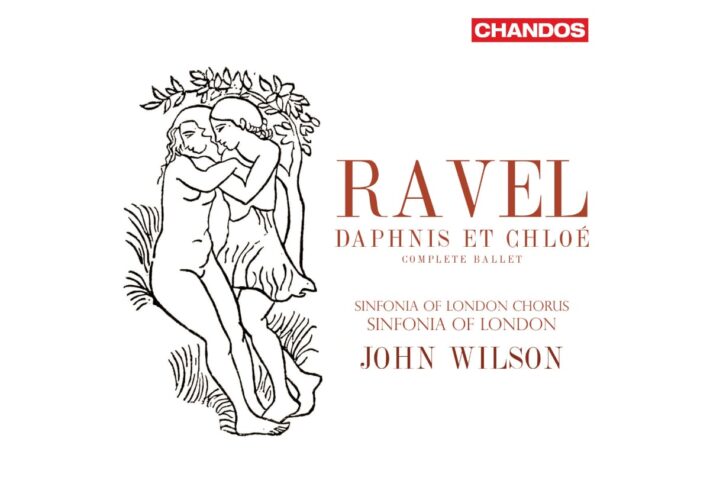The Chandos/John Wilson/Sinfonia of London team is quite busy, this being the fifth release of 2023. While their initial albums met with almost universal acclaim, more recent issues have received more circumspect reservations from (admittedly non-British) quarters. In my review of their previous Ravel album (February 2022) I suggested Wilson’s tight rein on his players, and a tendency to rush through climaxes, often weakened the emotional intensity of the performances. Now these same performers play Ravel’s largest orchestral work, in Wilson’s new critical edition, completed during Covid lockdowns.
Masterful control of dynamics and color in the opening impress, balance between wordless choir and orchestra perfectly managed. Yet when the first climax arrives (2’24”) it lacks emotional immediacy. Wilson then sets an overly quick tempo for the Danse religieuse. This is an important moment in the ballet’s story, as nymphs dance around Daphnis, arousing Chloé’s jealousy. Listeners must feel the sensuousness of the moment, but here the mood is businesslike. Turn to Dutoit’s classic reading and the passions are far more evident.
The following Danse Générale is marked Vif (brisk, lively), yet Wilson is slower than the previous section – why? Dorcon is trying to draw Chloé’s attention away from Daphnis: surely the mood should be frisky, suggesting Dorcan’s confident bravado? His ‘danse grotesque’ is clumsy, but Dutoit, Abbado and Boulez (Berlin) are clumsier still.
Similar issues are heard throughout the performance. The Danse de Lycéion (track 7) is chaste and polite, as if shepherdess Lyceion is unsure she really wants to tempt Daphnis into a tryst, whereas in Montreal (Dutoit) and Berlin (Boulez) the subtle shifts in color and weight make it plain she is trying everything she can to seduce Daphnis. And Wilson’s kidnapping pirates are rather polite (the Sinfonia held on too tight a leash) when compared to the threatening menace of Abbado’s gang (the LSO brass ripping into their lines).
Related Posts
- Review: Kenneth Fuchs – Orchestral Works, Vol. 1 – Wilson, Sinfonia of London
- Review: Rachmaninoff – Symphony No. 2 – Sinfonia of London, Wilson
- Review: Hollywood Soundstage – Wilson, Sinfonia of London
- Review: Respighi – Roman Trilogy – Sinfonia of London, John Wilson
At first, the Nocturne (track 8) seemed too fast, Wilson taking 3’19” versus Boulez’s 4’33” and Dutoit’s 5’07”. But Abbado’s reading is only ten seconds faster than Wilson, yet he conjures a far more vivid atmosphere. It is not an issue of tempo but Wilson’s objective coolness, in music that, at least as I understand it, is quite the opposite.
The choral introduction to the second Tableau (as well as the Sinfonia of London’s brass interjections) suggests a new, deeper level of connection, but coolness returns as the pirate’s dance begins (Danse guerrière, track 10), especially compares to the Dutoit and Abbado readings. And by this point I found myself frustrated with recording of the percussion – the Chandos engineers of the 1980s and 90s would never have allowed tam-tam strokes to sound so meek. Is this Wilson insisting on an overall color balance, even at moments where Ravel clearly intends percussion to dominate?
Which brings me to my point about this new edition. I am convinced that Wilson’s primary focus was listening that every correction was followed and recorded. He is aided in this by a typically expansive yet transparent recording that seems almost multi-miked to ensure every strand of the orchestral texture stands out in clear relief from one another. I repeatedly found myself drawn to the sound rather than the story, surely the opposite of what Ravel intends.
Viewing Georges Seurat’s “A Sunday on La Grande Jatte,” in Chicago, one can stand remarkably close to marvel at how those small dots of paint create an image. But the artist’s intent is not that we admire his pointillism technique, but rather that we stand away from the painting so that those precise points blur into the startlingly beautiful image that overwhelms one with thoughts and feelings. Frustratingly, for much of this recording, Wilson asks us to stand too close to the painting.
This is clearly seen if you compare Wilson’s “Lever du jour” (track 12) with Boulez’s Berlin reading. Wilson and his players ensure we hear everything in the score, and when dawn finally arrives the moment is loud and colorful. But with Boulez (who also ensures we hear every strand of orchestration) when dawn arrives there is an emotional transcendence, an ecstasy of wonder and possibility, that is only hinted at in this new reading.
Chandos’ ancillary materials are excellent: erudite notes by Roger Nichols, a brief discussion of the new edition by Wilson and the full libretto of the ballet, as well as several photos. Members of the choir are listed, but members of the orchestra are not – a strange omission. (Thankfully, the principal flute, Adam Walker, is credited.) While there are things to admire, this performance does not displace any of the recommended versions listed below.

Ravel – Daphnis et Chloé
Sinfonia of London
John Wilson – Conductor
Chandos, CHSA5327
Recommended Comparisons
Berliner Philharmoniker & Boulez (DG) | Montreal Symphony & Charles Dutoit (Decca) | LSO & Abbado (DG) | Rotterdam Philharmonic & Nézet-Séguin (BIS) | Stuttgart RSO des SWR & Denève (SWR Music)
Read more classical music reviews or visit The Classic Review Amazon store
Follow Us and Comment:
Get our periodic classical music newsletter with our recent reviews, news and beginners guides.
We respect your privacy.









